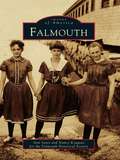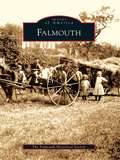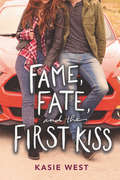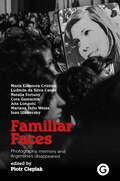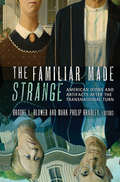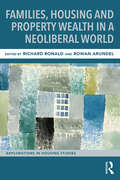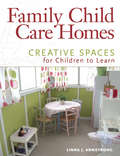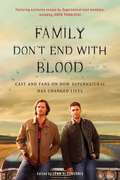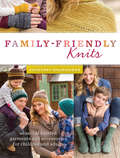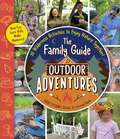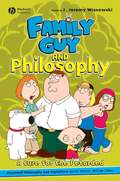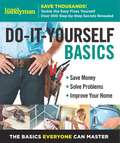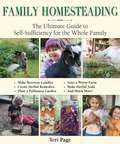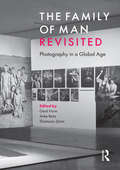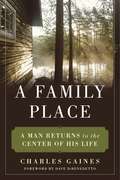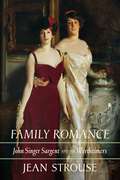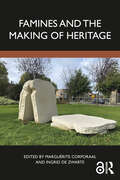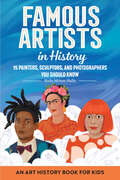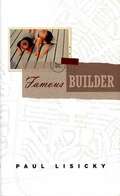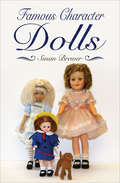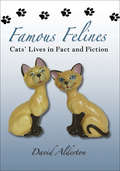- Table View
- List View
Falmouth (Images of America)
by Nancy Kougeas Falmouth Historical Society Ann SearsFor hundreds of years, people have been drawn to Falmouth, the town of the "shining sea," immortalized by Falmouth native Katherine Lee Bates in her poem America, the Beautiful. Quakers, farmers, whaling captains, marine scientists, Coast Guardsmen, summer residents, Portuguese immigrants from the Azores and Cape Verde Islands, vacationers, and retiring World War II veterans have all found a special place in Falmouth. The photographs in Falmouth celebrate these people and the town they have built. Through the eyes of nearly fifty photographers, these views capture the glorious natural and architectural heritage that has defined the three-hundred-and-forty-year history of this Cape Cod community. From the spare lines of the Quaker meetinghouse and the poorhouse to the spires of churches and the elaborate summer "cottages" of Falmouth's golden age in the 1880s, these vintage photographs offer a rich visual tour through the town's history. Unforgettable images of people-whalers posing for the camera on rare trips home, fishermen returning to port, cranberry pickers, and wealthy summer residents playing croquet in summer whites-combine to show the unique community that is Falmouth.
Falmouth (Images of America)
by The Falmouth Historical SocietyFalmouth began as a farming and fishing town with an active wooden ship-building industry along the Presumpscot River Estuary. The town later developed a number of small villages, each with a post office, stores, and its own school. Following the Civil War, the population dropped and did not begin to increase until the beginning of World War II. Wealthy Portland residents and out-of-state visitors established summer estates in Falmouth Foreside. With the introduction of the automobile and the electric trolley in the early 1900s, the Falmouth Foreside and West Falmouth areas enjoyed an influx of people who could live in Falmouth and work in Portland. After World War II, Falmouth continued to increase in size as roads were improved and more houses were built. Today Falmouth remains a growing community with extensive retail, health, retirement, and service facilities.
Fame Amid the Ruins: Italian Film Stardom in the Age of Neorealism
by Stephen GundleItalian cinema gave rise to a number of the best-known films of the postwar years, from Rome Open City to Bicycle Thieves. Although some neorealist film-makers would have preferred to abolish stars altogether, the public adored them and producers needed their help in relaunching the national film industry. This book explores the many conflicts that arose in Italy between 1945 and 1953 over stars and stardom, offering intimate studies of the careers of both well-known and less familiar figures, shedding new light on the close relationship forged between cinema and society during a time of political transition and shifting national identities.
Fame Amid the Ruins: Italian Film Stardom in the Age of Neorealism
by Stephen GundleItalian cinema gave rise to a number of the best-known films of the postwar years, from Rome Open City to Bicycle Thieves. Although some neorealist film-makers would have preferred to abolish stars altogether, the public adored them and producers needed their help in relaunching the national film industry. This book explores the many conflicts that arose in Italy between 1945 and 1953 over stars and stardom, offering intimate studies of the careers of both well-known and less familiar figures, shedding new light on the close relationship forged between cinema and society during a time of political transition and shifting national identities.
Fame, Fate, and the First Kiss
by Kasie WestFan favorite author Kasie West delivers an effervescent story about chasing your dreams and following your heart, perfect for fans of Jenny Han and Huntley Fitzpatrick. Lacey Barnes has dreamed of being an actress for as long as she can remember. So when she gets the opportunity to star in a movie alongside one of Hollywood’s hottest actors, she doesn’t hesitate to accept the part.But Lacey quickly learns that life in the spotlight isn’t as picture perfect as she imagined. She’s having trouble bonding with her costars, her father has hired the definition of a choir boy, Donavan Lake, to tutor her, and somewhere along the way she’s lost her acting mojo. And just when it seems like things couldn’t get any worse, it looks like someone on set is deliberately trying to sabotage her. As Lacey’s world spins out of control, it feels like the only person she can count on—whether it’s helping her try to unravel the mystery of who is out to get her or snap her out of her acting funk—is Donavan. But what she doesn’t count on is this straight-laced boy becoming another distraction.With her entire future riding on this movie, Lacey knows she can’t afford to get sidetracked by a crush. But for the first time in her life Lacey wonders if it’s true that the best stories really do happen when you go off script.
Familiar Faces: Photography, Memory, and Argentina’s Disappeared
by Piotr CieplakAn exploration of the rich and varied relationship between photography and the most recent Argentine dictatorship.Familiar Faces offers a diverse, theoretically rich, and empirically informed exploration of photography in Argentina&’s memorial, political, and artistic landscape. During the country&’s most recent civic-military dictatorship (1976–1983), 30,000 people were disappeared or killed by the state. Over the decades, vernacular and professional photographs have been central to the Argentine struggle for justice. They were used not only to protest the disappearances under the dictatorship and to denounce the authorities, but also as tools of political and social activism, and for remembering the disappeared.With contributions from leading Argentina-based anthropologists, ethnographers, curators, art scholars, media researchers, and photographers, Familiar Faces moves beyond the traditional considerations of representation, focusing instead on the ways in which photography is continuously reimagined as a tool of memory, mourning, and political and judicial activism. In so doing, it considers the diverse uses of press photography; artistic practice; photographs of the disappeared in domestic rituals; photographs of the inmates of torture centers; the reclamation of images taken by the dictatorial state for memorial and activist purposes. Written and published at a crucial moment in Argentine memory politics, Familiar Faces offers a geographically and formally diverse selection of case studies, with international as well as regional resonance. While firmly rooted in this national context, the book contributes to wider, global debates about the increasingly pervasive role of the photographic image in relation to state-sponsored, large-scale violence.
The Familiar Made Strange: American Icons and Artifacts after the Transnational Turn
by Mark Philip Bradley Brooke L. BlowerIn The Familiar Made Strange, twelve distinguished historians offer original and playful readings of American icons and artifacts that cut across rather than stop at the nation's borders to model new interpretive approaches to studying United States history. These leading practitioners of the "transnational turn" pause to consider such famous icons as John Singleton Copley's painting Watson and the Shark, Albert Eisenstaedt's photograph V-J Day, 1945, Times Square, and Alfred Kinsey's reports on sexual behavior, as well as more surprising but revealing artifacts like Josephine Baker's banana skirt and William Howard Taft's underpants. Together, they present a road map to the varying scales, angles and methods of transnational analysis that shed light on American politics, empire, gender, and the operation of power in everyday life. Contributors: Brooke L. Blower, Boston University; Mark Philip Bradley, University of Chicago; Nick Cullather, Indiana University; Brian DeLay, University of California-Berkeley; Matthew Pratt Guterl, Brown University; Jesse Hoffnung-Garskof, University of Michigan-Ann Arbor; Fredrik Logevall, Cornell University; Mary A. Renda, Mount Holyoke College; Daniel T. Rodgers, Princeton University; Andrew J. Rotter, Colgate University; Brian Rouleau, Texas A&M University; Naoko Shibusawa, Brown University
Families, Housing and Property Wealth in a Neoliberal World (Explorations in Housing Studies)
by Richard Ronald Rowan ArundelThe twenty-first century has so far been characterized by ongoing realignments in the organization of the economy around housing and real estate. Markets have boomed and bust and boomed again with residential property increasingly a focus of wealth accumulation practices. While analyses have largely focussed on global flows of capital and large institutions, families have served as critical actors. Housing properties are family goods that shape how members interact, organise themselves, and deal with the vicissitudes of everyday economic life. Families have, moreover, increasingly mobilized around their homes as assets, aligning household transitions and practices towards the accumulation of property wealth. The capacities of different families to realise this, however, are highly uneven with housing conditions becoming increasingly central to growing inequalities and processes of social stratification. This book addresses changing relationships between families and their homes over the latest period of neo-liberalization. The book confronts how transformations in households, life-course transitions, kinship and intergenerational relations shape, and are being shaped by, the shifting role of property markets in social and economic processes. The chapters explore this in terms of different aspects of home, family life and socioeconomic change across varied national contexts.
Family Child Care Homes
by Linda J. ArmstrongCreate a warm and inviting place where children feel at home.Discover the many ways your home can provide comfortable places where children love to learn and love to be. Filled with no- and low-cost ideas, this book demonstrates many unique and practical possibilities for your home's indoor and outdoor spaces. Chapters are packed with colorful photographs and provide examples and tips for designing learning zones, selecting items, organizing materials, and more. Checklists, resources, and questions are included to help you evaluate your setting, implement changes, and create a place that feels like a second home to the children in your care.
Family Don't End with Blood: Cast and Fans on How Supernatural Has Changed Lives
by Lynn S. ZubernisHow a Show, and the Support of Its Fandom, Changed—and Saved—Lives Supernatural, a three-time People's Choice Award winner for Favorite Sci-Fi/Fantasy TV Show and Tumblr's 2015 Most Reblogged "Live Action TV," has made a name for itself by supporting and encouraging its fans to "always keep fighting," and a memorable line from early in the show's run, "Family don't end with blood," became an inspiring mantra for many who found community in the fandom. In 25 powerful chapters written by Supernatural's actors and fans, including series lead Jared Padalecki, plus special messages from Jensen Ackles, Misha Collins, and Mark Sheppard, Family Don't End with Blood: Cast and Fans On How Supernatural Has Changed Lives examines the far reach of the show's impact for more than a decade. Supernatural has inspired fans to change their lives, from getting "sober for Sam" to escaping a cult to pursuing life-long dreams. But fans aren't the only ones who have been changed. The actors who bring the show to life have also found, in the show and its community, inspiration, courage, and the strength to keep going when life seemed too hard. Including essays and special messages from Supernatural 's cast: Jared Padelecki ("Sam Winchester") Jensen Ackles ("Dean Winchester") Misha Collins ("Castiel") Mark Sheppard ("Crowley") Jim Beaver ("Bobby Singer") Ruth Connell ("Rowena MacLeod") Osric Chau ("Kevin Tran") Rob Benedict ("Chuck Shurley aka God") Kim Rhodes ("Sheriff Jody Mills") Briana Buckmaster ("Sheriff Donna Hanscum") Matt Cohen ("Young John Winchester") Gil McKinney ("Henry Winchester") Rachel Miner ("Meg Masters") Collected and edited by Lynn S. Zubernis, a clinical psychologist, professor, and passionate Supernatural fangirl, Family Don't End with Blood provides an insightful and often uplifting look into the way international fan communities become powerful, positive forces in the lives of so many. In keeping with the show's message to "always keep fighting," a portion of the proceeds from the book will be donated to RANDOM ACTS, a nonprofit founded by Misha Collins, and AT TITUDES IN REVERSE, whose mission is to educate young people about mental health and suicide prevention.
Family-Friendly Knits: Seasonal Knitted Garments and Accessories for Children and Adults
by Courtney SpainhowerLove, Knit, Wear!Create garments and accessories your entire family will love with Family-Friendly Knits. Designer and mom Courtney Spainhower offers up a collection of designs you'll love to knit and everyone will want to wear, including:A selection of comfy yet stylish pullovers and cardigans for every seasonHats and cowls with interchangeable choose-your-own-adventure colorwork patternsA fabulously furry raglan sweater for your wild childA trio of fingerless mitts suitable for mama, papa, and babySocks for grown-ups and kids that are knit as one piece from cuff to cuff (to avoid "second sock" syndrome) Modern silhouettes and clever construction techniques make every project enticing to knit and functional for daily life. Whether you're stocking the family mitten basket, knitting yourself a Fair Isle cardigan you'll want to hand down to future generations, or whipping up gifts for loved ones near and far, Family-Friendly Knits has you covered.
The Family Guide to Outdoor Adventures: 30 Wilderness Activities to Enjoy Nature Together!
by Creek StewartExplore and experience nature with your kids with these 30 fun and educational family activities dedicated to spending more time outside.Less screen, more green! In the world of smartphones, tablets, and online learning, the need for children to engage with nature has never been more evident. Outdoor activities and projects inspire exploration, creativity, curiosity, learning, and a sense of wonder. Interacting with nature also fosters a healthy love and respect for the outdoors. The Family Guide to Outdoor Adventures features fun and engaging hands-on nature, camping, and bushcraft projects that get you and your children outside having more fun, strengthening your bond, and creating memories that will last a lifetime. Written by expert survival instructor Creek Stewart, each project is designed to get parents and their kids outside and teach them about nature and the great outdoors. From casting animal tracks and dyeing t-shirts with walnuts to building a debris hut and catching minnows with a spider web your family with get your hands dirty, learn some cool nature facts, and complete some awesome projects with your family. Explore, create, laugh, love, and experience the great outdoors together with The Family Guide to Outdoor Adventures.
Family Guy and Philosophy: A Cure for the Retarded
by J. Jeremy WisnewskiWisnewski (philosophy, Hartwick College) provides the analysis and some of the funny footnotes as he and his contributors work through postmodernism, religion and religious exclusivity, virtue and perversity, clueless men (in the character's case this is an oxymoron), motherhood, deadly sins, the importance of background people, dogs with personality, the logic of expectation, humor, fallacies, plagiarism, will and wantonness in wives, ego, and death. The result is fun, if you are a fan of the show, but even if you are not, you can get the point and most of the jokes.
Family Handyman Do-It-Yourself Basics Volume 2: Save Money, Solve Problems, Improve Your Home
by Family HandymanYou Can Do This! Save Thousands! Tackle the Easy Fixes Yourself Over 120 Step-by-Step Secrets Revealed The Basics Everyone Can MasterExcited to learn how to repair and improve your home yourself? Whether you own or rent, live in one room or 10, there are countless ways you can make your space better. With basic tools and skills, you’ll save money as you gain confidence in your DIY know-how.
Family Homesteading: The Ultimate Guide to Self-Sufficiency for the Whole Family
by Teri PagePractical advice and hands-on projects for the self-sufficient family In an increasingly digital world, families are looking for ways to deepen their connection to one another and to the land. The Family Homestead is a guide to a simpler life, one that integrates children into the daily work of creating a sustainable homestead. From gardening and cooking, to herbalism and natural crafts, The Family Homestead shares stories and hands-on projects that will deepen relationships and build self-sufficiency skills. Teri Page, author of the popular Homestead Honey blog, moved with her husband across country with young children to build their off-the-grid homestead on raw land. Together, they garden, forage, preserve foods, raise chickens, homeschool, and so much more. Perfect for homeschooling families or anyone working with or raising kids, readers will learn how to involve children in dozens of homesteading projects. Learn how to: Dye cloth with plant-based dyesMake beeswax candles Construct a rain barrel Hatch chicks Create a worm farm Grow giant pumpkins Make butter in a mason jar Make homemade herbal soda And so much more!
The Family of Man Revisited: Photography in a Global Age
by Gerd Hurm; Anke Reitz; Shamoon ZamirThe Family of Man is the most widely seen exhibition in the history of photography. The book of the exhibition, still in print, is also the most commercially successful photobook ever published. First shown at the Museum of Modern Art in New York in 1955, the exhibition travelled throughout the United States and to forty-six countries, and was seen by over nine million people. Edward Steichen conceived, curated and designed the exhibition. He explained its subject as `the everydayness of life' and `the essential oneness of mankind throughout the world'. The exhibition was a statement against war and the conflicts and divisions that threatened a common future for humanity after 1945. The popular international response was overwhelmingly enthusiastic. Many critics, however, have dismissed the exhibition as a form of sentimental humanism unable to address the challenges of history, politics and cultural difference.This book revises the critical debate about The Family of Man, challenging in particular the legacy of Roland Barthes's influential account of the exhibition. The expert contributors explore new contexts for understanding Steichen's work and they undertake radically new analyses of the formal dynamics of the exhibition. Also presented are documents about the exhibition never before available in English. Commentaries by critical theorist Max Horkheimer and novelist Wolfgang Koeppen, letters from photographer August Sander, and a poetic sequence on the images by Polish poet Witold Wirpsza enable and encourage new critical reflections. A detailed survey of audience responses in Munich from 1955 allows a rare glimpse of what visitors thought about the exhibition. Today, when armed conflict, environmental catastrophe and economic inequality continue to threaten our future, it seems timely to revisit The Family of Man.
A Family Place: A Man Returns to the Center of His Life
by Charles Gaines Dave DiBenedettoIn the summer of 1990, writer Charles Gaines and his artist wife, Patricia, bought 160 acres of wild land on the northeast coast of Nova Scotia. They believed they were simply buying a remote getaway spot, but within a few months a more complex dream for the property developed. By midwinter, they had begun to see the land as a place where family intimacy might be reclaimed, as a home that might heal their recently battered marriage, and as an opportunity to take on a big, risky, long-term project instead of settling into the caution and gradual losses of middle-class middle age. Enlisting their children and their daughter’s carpenter boyfriend, they decided to build a cabin on the land the following summer, to build it with their own hands, as a family venture.A Family Place gracefully mixes a narrative of that summer’s sometimes harrowing, sometimes hilarious, sometimes heartbreaking events with passages of the family’s history that show its members as real people and dramatize what is at stake for each of them in Nova Scotia. Gaines describes the process of building a cabin while living in tents without electricity or running water, and the pleasures and limitations of a life so simplified that a week’s biggest social event is a bonfire. He draws a deft portrait of the small, generous, hearth-centered Acadian community of farmers and lobster fishermen surrounding their land, and traces the history of that land to its original French-Acadian owner. And he tracks the mood of his family through the long, difficult summer, from initial enthusiasm to near mutiny, and finally to exhilaration and deep satisfaction at having built something that will last, having rebuilt a family in the process.
Family Romance: John Singer Sargent and the Wertheimers
by null Jean StrouseJean Strouse captures the dramas, mysteries, intrigues, and tragedies surrounding John Singer Sargent's portraits of the Wertheimer family.Jean Strouse’s Family Romance: John Singer Sargent and the Wertheimers looks at twelve portraits of one English family painted by the expatriate American artist at the height of his career—and at the intersections of all these lives with the sparkle and strife of the Edwardian age.In commissioning this grand series of paintings, Asher Wertheimer, an eminent London art dealer of German-Jewish descent, became Sargent’s greatest private patron and close friend. The Wertheimers worked with Rothschilds and royals, plutocrats and dukes—as did Sargent. Asher left most of his Sargent portraits to the National Gallery in London, a gift that elicited censure as well as praise: it was a new thing for a family of Jews to appear alongside the Anglo-Saxon aristocrats and dignitaries painted by earlier masters.Strouse’s account, set primarily in England around the turn of the twentieth century, takes in the declining fortunes of the British aristocracy and the dramatic rise of new power and wealth on both sides of the Atlantic. It travels back through hundreds of years to the Habsburg court in Vienna and forward to fascist Italy in the 1930s. Its depictions of Sargent, his sitters, their friendships and circles, and the portraits themselves light up a period that saw tumultuous social change and the birth of the modern art market.Sargent brilliantly portrayed these transformations, in which the Wertheimers were key players. Family Romance brings their interwoven stories fully to life for the first time.
Family Vista: The Memoirs of Margaret Chanler Aldrich
by Margaret Chanler AldrichFirst published in 1958, these are the memoirs of Margaret Chanler Aldrich, a descendant of the prominent Astor family. A nurse for the American Red Cross during the Spanish-American War, and later the Philippine-American War, Aldrich joined the woman’s suffrage movement and became notable as one of Carrie Chapman Catt’s capable officials in the campaign for suffrage in New York State.A fascinating autobiography!
Famines and the Making of Heritage
by Marguérite Corporaal Ingrid De ZwarteFamines and the Making of Heritage is the first book to bring together groundbreaking research on the role of European famines in the nineteenth and twentieth centuries in relation to heritage making, museology, commemoration, education, and monument creation.Featuring contributions from famine experts across Europe and North America, the volume adopts a pioneering transnational perspective, and discusses issues such as contestable and repressed heritage, materiality, dark tourism, education on famines, oral history, multidirectional memory, and visceral empathy. Questioning why educational curricula and practices in schools and on heritage sites are region- or nation-oriented or transnational, chapters also consider whether they emphasise conflict or mutual understanding. Contributions also consider how present issues of European concern – such as globalisation, commodification, human rights, poverty, and migration – intersect with the heritage and memory of modern European famines. Lastly, the book considers what role emigrant and diasporic communities within and outside Europe play in the development of famine heritage and educational practices – and whether famine heritage is accessible to them.Famines and the Making of Heritage provides a crucial resource for museum and heritage scholars, students and professionals working on or with difficult or dark heritages, as well as those interested in the study of famines and legacies of troubled pasts.
Famous Artists in History: An Art History Book for Kids (Biographies for Kids)
by Kelly Milner HallsAmazing stories of artists with a unique view of the world—for kids ages 8 to 12 Art makes the world a more beautiful and interesting place! Throughout history, all over the world, artists have created incredible pieces that inspired the hearts and minds of millions of people. This collection of biographies for kids explores the accomplishments of 15 artists from long ago and today, and how their diverse experiences and beliefs brought their work to life. This book of famous artists for kids includes: Stories set in stone—Learn about sculptors like Michelangelo and Gian Lorenzo Bernini, and how they used marble to make human bodies in incredible detail. Powerful pictures—Read the stories of photographers like Julia Margaret Cameron and Gordon Parks who captured the lives of ordinary people to draw attention to their struggles. Art as self-expression—Discover how Frida Kahlo and Jean-Michel Basquiat used their vibrant painting style to make bold statements about who they were and where they were from. Show any kid that they have a strong and creative point of view with this illuminating art history book.
Famous Builder
by Paul LisickyPaul Lisicky remembers being not much like other boys his age, but rather the awkward thirteen-year-old with "arms thick as drinking straws," who composes tunes in his head that he might later send to Folk Mass Today or to the producers of The Partridge Family. Born into a family whose incremental success bumps them up a notch from their immigrant upbringing and into suburban America, Paul puts his creative, undaunted energy into drawing intricate housing development plans and writing liturgical music. In the lively, loving essays contained in Famous Builder, Lisicky explores the constant impulse to rebuild the self. With gracious, thoughtful candor and pitch-perfect humor, he explores the very personal realms of childhood dreams and ambitions, adolescent sexual awakenings, and adult realities.
Famous Character Dolls
by Susan BrewerPart of the popular Famous series, Famous Dolls celebrates dolls in film, TV, cartoons, books, comics and comic strips, as well as toys such as Hamble in Playschool. It also explores the world of celebrity dolls including stars such as Shirley Temple and Mae West, pop star dolls including Michael Jackson and Cher, and dolls representing royalty. Written by leading doll expert, Susan Brewer, the author of British Dolls in the 1950s and British Dolls in the 1960s, the book starts with a series of essays setting dolls in context and exploring their role in popular culture. The main part of the book is an impressive A-Z of famous dolls, with symbols to show in which field they became famous (e.g. cartoons, toys or comic strips). The stories behind each of the dolls are told, including the tragic tale of Raggedy Ann and how a little girl inspired one of the most iconic character dolls of all time. A must-buy book for everyone who has ever own or collected dolls or is interested in popular culture.Did you know? The author of Raggedy Ann, Johnny Gruelle, was a vehement anti-vaccination campaigner after his young daughter died when she was vaccinated at school without his consent Angela Rippon created the Victoria Plum doll series based on a plum tree in her garden Holly Hobbie is an author and illustrator who named the famous patchwork-wearing little girl after her. It became a popular doll in the 1970s
Famous Felines: Cats' Lives in Fact and Fiction
by David AldertonA delightful hiss-torical survey of cats in popular culture. Louis Wain and Beatrix Potter adored them, but Walt Disney preferred dogs; cats have been depicted in art, books and, more recently, film and TV as lovable but determined creatures. Where the dog is loving but stupid, the cat is clever but sly. Bestselling author David Alderton explores this myth and reveals just who the most famous cats are, including cartoon classics such as Top Cat, Felix, and the dastardly Si and Am from 101 Dalmatians. Using collectible memorabilia and original book covers, this charming book is a purr-fect stocking filler, along with its doggish counterpart, Famous Dogs by Fiona Shoop—ideal packaged together.
Famous for 15 Minutes: My Years with Andy Warhol
by Ultra VioletOne of Andy Warhol&’s superstars recalls the birth of an art movement—and the death of an icon In this audacious tell-all memoir, Ultra Violet, born Isabelle Collin Dufresne, relives her years with Andy Warhol at the Factory and all of the madness that accompanied the sometimes-violent delivery of pop art. Starting with her botched seduction of the &“shy, near-blind, bald, gay albino&” from Pittsburgh, Ultra Violet installs herself in Warhol&’s world, becoming his muse for years to come. But she does more than just inspire; she also watches, listens, and remembers, revealing herself to be an ideal tour guide to the &“assembly line for art, sex, drugs, and film&” that is the Factory. Famous for 15 Minutes drips with juicy details about celebrities and cultural figures in vignettes filled with surreptitious cocaine spoons, shameless sex, and insights into perhaps the most recognizable but least intimately known artist in the world. Beyond the legendary artist himself are the throngs of Factory &“regulars&”—Billy Name, Baby Jane Holzer, Brigid Polk—and the more transient celebrities who make appearances—Bob Dylan, Jane Fonda, Jimi Hendrix, John Lennon. Delightfully bizarre and always entertaining, filled with colorful scenes and larger-than-life personalities, this dishy page-turner is shot through with the author&’s vivid imagery and piercing observations of a cultural idol and his eclectic, voyeuristic, altogether riveting world.
